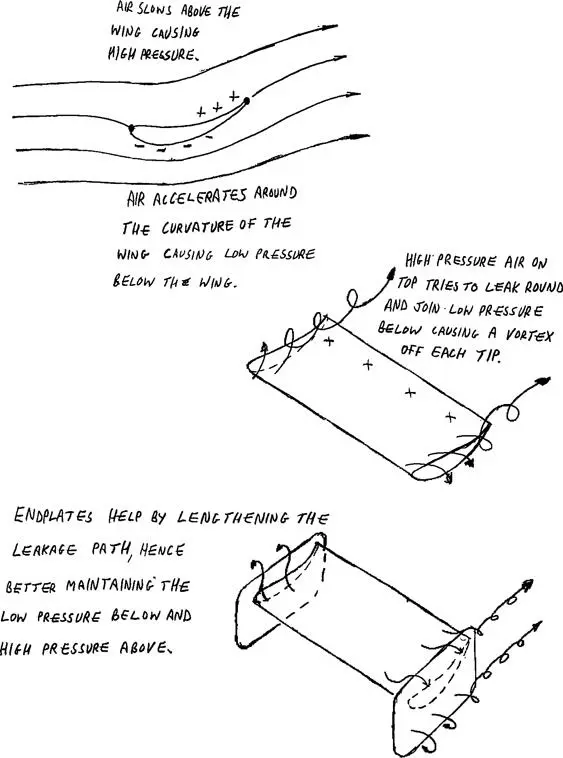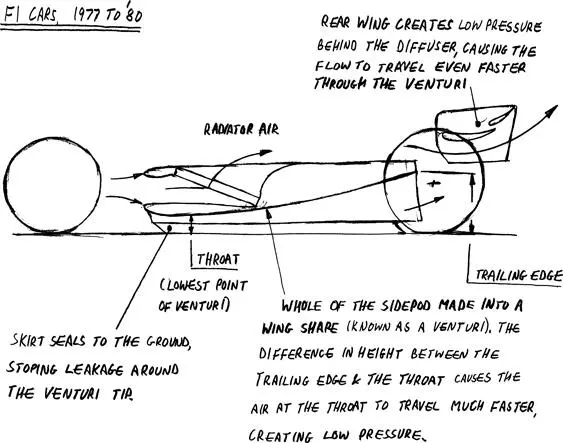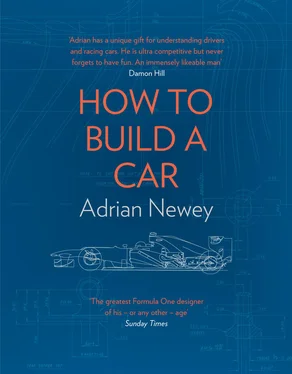The second year at Southampton was a bit more interesting, geared as it was towards the more practical side of things, which was my strength. The lectures were no longer all about background theory; we started to learn about applied engineering as well as gearing up for what would prove to be my favourite element of the course: the final-year project.
Fate, luck and chance were also playing their part. I started at Southampton in 1977 and graduated in 1980. Those three years just happened to be a time of seismic change in Formula One.
Which is where it starts to get really interesting.
To make a racing car accelerate and achieve a higher top speed you need more power, less weight and less aerodynamic drag. And if that sounds like a simple set of goals, it probably would be, if not for the troublesome mechanics of cornering. A light car is able to change direction quickly, but it’s a misconception that a heavier car offers more grip. Tyres behave in a non-linear way, which means that if the load on the tyres is doubled during cornering they don’t offer twice the cornering force. To corner at the same speed, a car that weighs twice as much would need twice the grip and would accelerate more slowly.
This is where downforce comes in. Downforce is what we call the pressure that pushes the car downwards, effectively suckering it to the track. And because the generation of downforce is something that happens as a result of the aerodynamic shaping of the car, you can increase grip without it involving a significant increase in weight. In other words, you get to have your cake and eat it: more grip without a loss of acceleration.
Thus, the aim of the chassis designer is to:
One: ensure that the tyres are presented to the ground in an even and consistent manner through the braking, cornering and acceleration phases.
Two: ensure the car is as light as possible.
Three: ensure that the car generates as little drag as possible.
Four: ensure that the car is generating as much downforce as possible in a balanced manner throughout the phases of the corner.
Downforce was a still relatively poorly researched area in motorsport in 1977. Having sat out the 1940s and 1950s altogether, it then played a small part in the 1960s when teams began fitting spoilers to sports cars, typically at Le Mans where the inherent lift of the cars’ body shapes had led to drivers complaining of instability on the long, fast straights and kinks of that circuit. With the introduction of a very large rear wing by Jim Hall of Chaparral in 1967, cars started generating significant downforce for the first time, having literally looked to the skies for inspiration – to aircraft.
An aeroplane lifts because the contours of its wing cause air to flow at different speeds across the two sides, low pressure on the topside, high on the other, with the wing moving in the direction of the low pressure and giving us what we call ‘positive lift’ as a result.
The wing on a racing car works the same way, but in reverse: ‘negative lift’, or ‘downforce’, pressing the car into the ground and hence allowing the tyres to generate more grip.
With this blindingly simple solution established, wings on racing cars became a common feature of the 1970s, with teams continually seeking to create more downforce, but with little further progress, until 1977.
To explain what happened in 1977, please first allow me to offer a brief lesson in aerodynamics. The pressure difference across the surface of the wing creates a distortion of the flow field as it passes through the air, known as circulation. In the case of a racing car, this means that air behind the car is thrown upwards, creating a rooster tail of air behind the car that can clearly be seen when Formula One cars run in the wet. However, the air on the high-pressure side of the wing is also able to leak around the tips of the wing, reducing the low pressure on the suction side and hence reducing the wing’s efficiency. This tip leakage, when combined with the forward motion of the vehicle, sets up a spiral, tornado-like structure known as the tip vortex. These tip vortices can be seen spilling from the rear wing when a Formula One car runs on a damp day or indeed on the wings of aircraft as they come in to land in the same conditions.

Figure 2:How a wing works and how it forms a vortex at its tips.
Aircraft (and birds) reduce this loss of efficiency of their wings by increasing span, exemplified by sailplanes, which have very long slender wings. However, in 1968, following a spate of accidents in Formula One caused by the long span, high wings used during the period collapsing, regulations were introduced to restrict their span. Teams responded by fitting plates to the ends of their chopped-down wings, which helped to create a more tortuous leak path between the upper and lower surfaces of the wing, but overall efficiency was reduced. This, simplistically, remained state-of-the-art technology in Formula One from 1968 to 1977.

Figure 3:Making the sidepods of the car into a huge wing.
But nature, as is so often the case, had already worked out an efficient solution to the problem of how to make a wing of a given span much more efficient. If you watch a heavy river bird such as a swan, it will often fly just above the water, with the tips of its wings on the edge of dipping in. In doing so, it harnesses two powerful effects:
(1) If its wing tips just touch the water’s surface, the leak path is sealed, the low pressure on the suction surface is not compromised and the wing hence becomes much more efficient.
(2) The downwash of air behind the wing (created by circulation) reacts against the river’s surface, creating a higher pressure underneath the wing – a phenomenon known as ‘ground effect’.
Turn this upside down, so that you have a downforce-generating wing with its endplate rubbing on the ground, and suddenly you have a massively effective solution. This is exactly what Lotus did in 1977, using much of the underside of the car to create an enormous wing, sealed to the ground at its tips by ‘sliding skirts’.
It was an innovation that today we’d call a ‘disruptive technology’, a game-changer that pushed aerodynamics firmly to the forefront of racing car design.
Which is where I come in, because while all this was happening in the late 1970s, I was at university studying aerodynamics and hoping for a career in Formula One – a sport that had suddenly recognised the importance of aerodynamics.
You have to remember that at this time, racing teams were quite small – a staff of around 30 compared to the 800 or so we have at Red Bull today – and designers were mainly mechanical engineers; very few had studied aeronautics. They were trying to teach themselves, and, as such, development was somewhat haphazard.
It’s not a criticism. Far from it. If I could go back to design at any point in the sport’s history, it would be then, because if you look at the cars on the grid from the early to late 1970s, they all looked very different to each other. The rulebook then was small; they had a huge amount of freedom, but relatively little understanding of the end product, purely because they didn’t have the research tools that we benefit from today; they were only just waking up to the possibilities of wind tunnels and the kind of simulation tools we now use routinely.
But they were pioneers. They’d be trying new suspension geometries, ‘anti-dive’, ‘anti-lift’ or adaptable suspension that ended up flexing like bits of chocolate. Great ideas that somebody came up with in the shower or standing at their drawing board staring off into space. All of them released to great fanfare and acclaim. Most of them abandoned almost immediately. Giddy times.
Читать дальше














